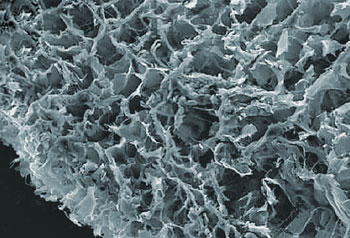Scientists have designed and tested biocompatible material that forms a gel in vivo and is capable of slowly releasing protein drugs.
Protein drugs are used to treat a wide range of illnesses but their therapeutic effects are limited by their unstable nature. The drugs are easily denatured in the body and administering them intravenously or via oral pills often causes plasma concentrations that are either too low to have a therapeutic effect or too high and cause toxicity. Delivery of protein drugs over a sustained period of time to a localised area would greatly enhance their therapeutic benefits.
Moon Suk Kim of Ajou University, Suwon, South Korea, and his team, designed and the gel using biocompatible components, sodium carboxymethylcellulose and polyethyleneimine, that electrostatically link to form a gel on exposure to physiological conditions. The gel was found to be porous enough to release the test protein drug, albumen, in a slow and controlled manner for up to 15 days, while preventing biological materials from entering.

The hydrogel releases protein drugs over a period of 15 days
|
David Dunstan, an expert in drug delivery systems at Melbourne University comments, 'a significant revolution in the delivery of therapeutic agents is occurring. While considerable focus has been on the use of nanoparticles, alternative methods such as reported in this work are showing considerable promise.'
Kim says 'we believe the results of the present study provide new options for sustained in vivo release of highly potent therapeutics, and represent a useful experimental platform for future protein delivery research.' The team intends to continue testing hydrogels in the same way with the aim of improving their clinical use.
Harriet Brewerton
Enjoy this story? Spread the word using the 'tools' menu on the left or add a comment to the Chemistry World blog.




